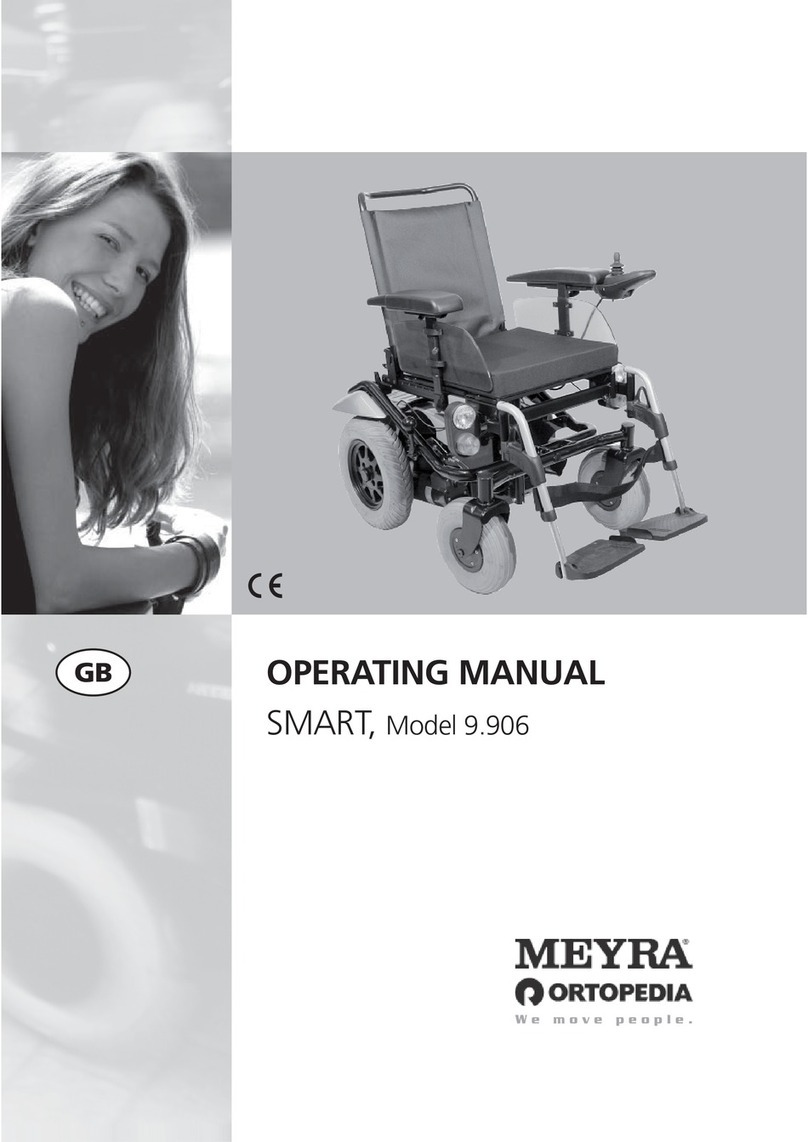Meyra 2.432 User manual

1
GB
ELECTRONIC WHEELCHAIR
OPERATING MANUAL
GB
D–GB–F–I–E–NL
POWER PRIMUS II
Model 2.432
OPERATING MANUAL
WHEELCHAIRS AND REHABILITATION EQUIPMENT

2
TABLE OF CONTENTS
Introduction 3
Acceptance 3
Assembly 3
Specifications / Utilization 3
General overview 4
Safety instructions 4
Driving behavior 6
Brakes 7
Preparing the wheelchair for operation 8
Pre-operation checks 8
Control box 9
Legrests 10
Side parts 12
Backrest 13
Seat belt 14
Push mode 14
Folding/unfolding 14
Dismantling for transportation 15
Safety belt 16
Lighting code 932 16
Loading and transportation of the wheelchair 17
Service 18
Maintenance 18
Cleaning 18
Spare parts 18
Maintenance instructions 18
Service 18
Batteries 18
Charging procedure 18
Lighting code 932 20
Maintenance instructions 21
Fuses 22
Fault clearance 22
Technical specifications 23
Inspection certificate 25
Guarantee 27
Guarantee note 27
Illustration section of the operating manual 29

3
GB
ASSEMBLY
Our specialist workshop supplies your
wheelchair ready for use and adjusted
to suit your special requirements.
SPECIFICATIONS/
UTILIZATION
The POWER PRIMUS II, Model 2.432,
was designed for indoor and outdoor
use. It is not suitable for use on all fixed
ramps. Only travel downhill at the lo-
west pre-selected final speed!
Please observe the Safety Instructions!
The wheelchair is designed to carry one
passenger only on the seat with mounted
side parts and legrests. It should not be
used as a traction mechanism, means of
transportation etc.
Please observe the Safety Instructions!
With the POWER PRIMUS II, you can
negotiate obstacles of up to 50 cm in
height, depending on the positioning of
the legrests.
Please observe the Technical Specifi-
cations!
INTRODUCTION
The
"POWER PRIMUS II" Electronic
Wheelchair, Model 2.432,
is ideal for
persons who require maximum mobility
in extremely confined spaces. This app-
lies, for example, to the home, the of-
fice and also to rooms that you visit in
your leisure time. This is what the
wheelchair was designed for and whe-
re you can test its driving performance
and special design features. This
wheelchair concept is also entirely suita-
ble for outdoor use.
Many details, such as
– short frame
– adjustment options (control box, arm-
rest, legrests)
– exceptionally simple folding proce-
dure
– low transport weight
– problem-free transition to push mode
– and, not least, outstanding kilometric
performance
make this wheelchair a genuine partner.
This operating manual will give you all
the information your require – clearly
written and with illustrations.
Read and observe this operating
manual before you use the
wheelchair for the first time.
Pictures and graphic illustrations
are contained in the appended
illustration part.
ACCEPTANCE
All MEYRA wheelchairs are tested in our
factory for fault-free operation, and are
packed in special boxes.
However, we request that you check the
vehicle for possible transport damage
immediately on receipt – preferably in
the presence of the carrier.
Please arrange the following if you be-
lieve damage occurred during trans-
port:
a) Draw up a DAMAGE REPORT – the
carrier is required to do this.
b) Draw up aLETTER OF SUBROGATI-
ON – you assign to the supplier all
claims resulting from this damage.
c) Send back the BILL OF LADING, the
DAMAGE REPORT and the LETTER
OF SUBROGATION to us.
We are unable to accept any claims for
compensation if you fail to observe these
instructions or notify us of damage after
the goods have been accepted.

4
GENERAL OVERVIEW
POWER PRIMUS II, Model 2.432
The model shown in Fig. 1 is the stan-
dard version. All deviations are speci-
fied separately in this operating manual.
Fig. 1 shows Model 2.432
Fig. 2 shows the control box
No. Designation
1 Push handle
2 Backrest
3 Side part with armrest
4 Seat belt
5 Legrest
6 Footrest
7 Lower leg strap
8 Steering wheel
9 Drive
10 Drive wheel
11 Brake release lever
12 Control box
13 Battery holder with batteries
14 Support wheel
15 Adjustment screw - backrest
16 Joystick
17 I/O button (on/off)
18 Hoop guard
19 Battery symbol (charging status)
20 Dial for selection of maximum fi-
nal speed
SAFETY INSTRUCTIONS
Please also refer to S_01 - S_12 in the
illustration section.
• Read and observe this operating
manual before you use the
wheelchair for the first time.
• Only use the wheelchair on firm sur-
faces – it may overturn if operated
with one side on a soft verge!
• Each time you break your journey,
the selection lever must be set to
drive mode.
• Ensure that the wheelchair cannot be
used by unauthorised persons. – Set
the selection lever to drive mode
and park in a safe place.
• When adjusting the wheelchair set-
tings, keep your hands away from
the adjustment area. – Danger of
crushing!
• The wheelchair is only licensed to
carry one person.
• Luggage should only be carried safe-
ly in bags which are specially desi-
gned for use on the wheelchair.
• Whenever possible, ensure that you
do not travel alone so that assistance
is to hand in case of malfunction.
• When travelling on public roads,
observe the relevant statutory provi-
sions, despite the fact that a driving
license is not required.
• Obtain information about obligatory
third party liability insurance. – A re-
quirement in Germany for every
electronic wheelchair capable of
speeds exceeding 6 km/h and re-
commended for all electronic
wheelchair users.
• Do not attempt special driving situati-
ons, e.g. negotiating hills, descents,
obstacles and poor road surfaces
without assistance.
• When negotiating narrow spaces
e.g. building entrances, doors etc.,
take care not to trap the lower arms.
– Danger of injury to the lower arms.
• Avoid jerky adjustments to driving
status when negotiating hills, trans-
verse slopes and obstacles.
• Adapt the pre-selectable final speed
to the given conditions.
• Adapt and reduce speed when tra-
velling up or downhill in accordance
with gradient. – Always, ensure that
you never exceed the maximum
speed of 6 km/h.
• Apply the wheelchair brakes careful-
ly, especially on downhill slopes. –
Danger of overturning!
• Braking sharply, especially on down-
hill slopes, can cause the wheelchair
user to be thrown out of the front of
the wheelchair, depending on physi-
cal condition.
• Braking too sharply when travelling
backwards on downhill slopes can
cause the wheelchair to overturn.
• Wearing the safety belt prevents the
user from being thrown out of the
front of the wheelchair when bra-
king, especially on downhill slopes.
• Depending on the maximum final
speed setting, there may be a so-
called neutral zone when the joystick
is first activated. This can cause the
wheelchair to roll backwards on hills
or when negotiating obstacles. –
Pass through this neutral zone as
quickly as possible!

5
GB
• Select a low final speed in driving
situations which you do not feel com-
fortable with (e.g. operation in confi-
ned spaces or on hills, e.g. on
ramps).
• Operation of the wheelchair after
removing the control box is only per-
mitted when the therapy table is
being lowered and raised! – Dan-
ger of accidents!
• When getting into/out of the
wheelchair, do not put any weight on
the footrests.
• Do not support yourself on the control
box.
• Only push the wheelchair on flat sur-
faces when shunting or in an emer-
gency. – Take weather and road
conditions into account.
• When travelling up or downhill, ne-
ver set the selection lever for drive/
push mode at push mode. This makes
steering the wheelchair impossible
and braking is then only possible via
the selection lever.
• At the end of a downhill slope, ensu-
re that the footrests do not come into
contact with the ground as this will
cause the wheelchair to brake sud-
denly and put the occupant at risk.
• Negotiate an obstacle with both
front and both back wheels simulta-
neously.
• The wheelchair is at particular risk of
overturning when the drive wheels
are passing over the edge of an
obstacle.
• When descending a step, you are at
risk of falling forward out of the
wheelchair if the footrests or legrests
come into contact with the road sur-
face.
• To ensure safe lateral support, espe-
cially when negotiating corners, ne-
ver use the wheelchair without pro-
perly adjusted side parts.
• Do not use the wheelchair without
stabilisers. – They increase its stabili-
ty. In difficult situations, e.g. when
negotiating obstacles, the stabilisers
can lift the drive wheels off the
ground. This will render the
wheelchair inoperable.
• Do not use the wheelchair on escala-
tors.
• Do not use the wheelchair on ramps
or lifting equipment without fixed side
railings.
• Do not use the wheelchair when un-
der the influence of alcohol or drugs.
• Do not get into/out of the wheelchair
unless it is switched off and the selec-
tion lever has been set to drive
mode! – Inadvertently knocking the
control lever (16) will set the
wheelchair in motion without control!
– Danger of accidents!
• Protect the wheelchair against water
and damp.
• It is best to charge the battery over-
night. Full recharging of the batteries
takes 12 to 15 hours.
• Do not recharge the batteries in a
damp room or enclosed space. –
The charging process can produce
toxic fumes. Ensure that the room is
well-ventilated!
• Only use a battery charger which is
designed for the battery in question!
– Otherwise, the batteries may be
destroyed.
• When working on the battery, remo-
ve the main safety fuse and ensure
that tools and metal objects do not
come into contact with the battery
terminals. – Risk of short circuit and
explosion! Avoid naked flames and
sparks in the vicinity of the batteries.
– Risk of explosion!
• Do not open the batteries by force.
• Never use a naked flame or cause
sparks close to the battery. – Risk of
explosion!
• Only replace defective safety fuses
with fuses of the same type. Do not
attempt to repair them. – Risk of fire!
• Batteries should be replaced by a
specialist workshop only. Batteries
can explode if they come into contact
with sparks, e.g. due to a short cir-
cuit of the battery terminals.
• Excessively high operating and stora-
ge temperatures can cause dama-
ge!
• Clean, passive lighting is required
for driving in public traffic.

6
DRIVING BEHAVIOR
A brief "familiarisation phase" of
driver
training
is initially necessary to adapt
the special driving features of an unfami-
liar vehicle, be it wheelchair or car, to
your personal circumstances.
Drive with extreme caution during
these first trips.
Bearing this in mind, set the pre-selecta-
ble final speed to the lowest setting.
Turn the dial (20) on the control box
in an anticlockwise direction as far
as possible,
(see "Pre-Operation
Checks).
Please observe the Safety Instructions!
Each time you use the wheelchair, you
will be confronted with and have to
cope with new situations, as is the case
in all areas of life, e.g. in the family or
at work. Take advantage of the
versa-
tility
of the POWER PRIMUS II Electro-
nic Wheelchair in adapting to the speci-
fic requirements of its user. This offers
you
you outstanding driving comfort
and
high operational safety.
This operating manual will give you all
necessary information.
You determine the
speed and direction
of travel
travel while in motion by mo-
ving the joystick (16). For example,
push the joystick slowly forwards and the
wheelchair also moves slowly forwards.
This also applies to moving the joystick
to the side when steering the Electronic
Wheelchair. The wheelchair moves in
the same direction as the joystick.
Use the
dial (20)
to select the maximum
final speed of your wheelchair
when
the wheel chair is stationary or in
motion
.
The selection of the correct speed is
important for a safe journey!
See the section entitled "Pre-Operati-
on Checks"
There is a slight interval between mo-
ving the joystick and the wheelchair set-
ting in motion
(neutral zone)
. This has
the advantage that the wheelchair does
not move immediately and endanger
other persons or objects if the joystick is
inadvertently activated.
Turning in confined spaces
The POWER PRIMUS II is fitted with two
drive motors. These permit the turning
and manoeuvring of the wheelchair in
confined spaces.
Please observe the Safety Instructions!
Braking the wheelchair
The wheelchair stops when you let go of
the joystick.
Note!
Braking the wheelchair when tra-
velling downhill at high speed
can
cause it to skid. –
Danger of acci-
dents!
When travelling downhill, select a
low speed!
Always ensure an adequate
braking
distance
when applying the wheelchair
brakes.
Note!
The shortest
braking distance
for the
"POWER PRIMUS II" Model 2.432 is
approx.
1m for the 6 km/h
– versi-
on, depending on road surface and
speed. . For this reason, ensure that
you brake the wheelchair in good
time when you encounter other peop-
le or obstacles.
• If drive mode is switched off
(bra-
ke release lever in the "push"
position)
the wheelchair cannot be
operated and braked via the joy-
stick! In this event, use the
brake
release lever (shift to the
"drive" position). – Danger of
accidents!
• Please observe the Safety Instruc-
tions!
Note!
Mobile telephones
telephones and
other radio equipment should only be
used when the wheelchair is
stationa-
ry
(control box switched off) for rea-
sons of safety.
Although the wheelchair conforms with
the statutory EMV regulations, it can cau-
se unintentional interference noise if
operated in the vicinity of sensitive elec-
tronic equipment (e.g. buzzing, hum-
ming).
The wheelchair can also interfere with
electromagnetic fields, e.g. such as tho-
se emitted by shop anti-theft systems.

7
GB
Before performing maintenance
work, dismantling/mounting parts
or adjusting the settings
on the
wheelchair,
push the brake release
lever to the "drive" position
and
switch off the control box! – Accident
risk
risk resulting from inadvertent mo-
vement of the wheelchair!
• Negotiating curbs
Curbs can be negotiated with the
detachable curb aid Code 862.
Please observe the operating ma-
nual which is supplied with Code
862.
BRAKES
The brakes are one of the most im-
portant safety features of a wheelchair.
The POWER PRIMUS II is fitted as stan-
dard with two independently-operating
braking systems.
1. The motor brake:
An electronic service brake which
brakes the wheelchair gently
without jerking.
2. The safety magnetic brakes:
These are used only when the
wheelchair is stationary. They are
activated by way of the selection
lever for drive/push mode. At the
same time, they guarantee the
automatic braking of the
wheelchair in the event of a power
failure.
The POWER PRIMUS II, Model 2.432
is not fitted with an additional drum bra-
ke for parking.
The electromagnetic brake is swit-
ched from drive to push mode by way
of the brake release lever on the side
of the wheelchair! – Also observe the
signs affixed to the left and right of the
brake release lever.
Note!
Danger of crushing between the drive
wheel and frame.
When the selection lever is set to
drive mode, the electromagnetic bra-
ke takes effect immediately.
– Con-
trolled braking is not possible!
Please observe the Safety Instructions!
BRAKE RELEASE LEVER
Locking the brake
Push the brake release lever (11) for-
ward as far as it will go, (Fig. 3).
Note!
It is impossible to push the wheelchair
when in drive mode.
The
brake performance decreases
when:
– the brake pads are worn.
If the wheelchair demonstrates an un-
even or impaired braking effect, take
it immediatelyto your
specialist
workshop
for repair.
Releasing the brake
Pull the knob on the brake release lever
and pull the brake release lever back
as far as it will go (Fig. 4).
Note!
Do not
get into/out of
the
wheelchair unless it is
is switched off
and the selection lever has been
set to drive mode.
Inadvertently knocking the control le-
ver (16) will set the wheelchair in
motion without control! –
Danger of
accidents!
DRIVING BEHAVIOR

8
PREPARING THE
WHEELCHAIR FOR
OPERATION
Follow the instructions below in the
stated order.
1. Shift to drive mode.
Push the brake release lever
forward into drive mode, (Fig. 3).
Note!
Do not switch to push mode when the
wheelchair is in operation!
2. Check battery plug connection
The battery plug for main power
supply is in front of the battery
cover under the crossbrace,
(Fig.6).
3. Position of the control box
The control box should be
positioned in such a way that you
can comfortably and safely steer
the wheelchair.
Longitudinal adjustment:
Loosen adjustment screw (A, Fig. 7).
Height adjustment
The height positioning of the control box
is adjusted by way of adjusting screw (B,
Fig. 7) on the height adjustable armrest,
(also refer to the section entitled "Side
Parts").
Do not forget to
tighten the adjusting screws again.
PRE-OPERATION
CHECKS
PRE-SELECTION OF FINAL SPEED
The pre-selectable maximum final
speed is set by way of the dial (20) on
the control box (Fig. 2), either while the
wheelchair is stationary or in motion.
Note!
When travelling up or downhill
adapt and
reduce speed
in accor-
dance with gradient.
Never exceed
the admissible maximum speed (de-
pending on model
of 6 km/h
). –
Danger of accidents!
Have you selected an appropriate
maximum final speed?
The maximum final speed should reflect
the given conditions.
Note!
Risk of accident
by the selection of
an
inappropriate maximum final
speed setting!
Always select a
low final speed
in
driving situations which you do not feel
comfortable with (e.g. operation in-
confined spaces
or travelling uphill
on
ramps
etc.).
5. Switch on control box
Press the I/O button (17) on the
control box, (Fig. 8).
– The LED on the battery control
display (19) lights up. (Also refer to
the section entitled
"Control
Box"
).
6. Setting final speed
The pre-selectable final speed is
set by way of the dial (20) on the
control box (Fig. 2).
Low final speed
Turn the dial in an anticlockwise
direction as far as it will go.
High final speed
Turn the dial in a clockwise
direction as far as it will go.
Note!
• Risk of accident by the selection of
an inappropriate maximum final
speed setting!
Select a low final speed in driving
situations which you do not feel
comfortable with (e.g. operation in
confined spaces or on hills, e.g. on
ramps).
Always check the following before
setting off:
–
battery charging status
– the
selected maximum speed
.
(Please refer to section entitled
"
Control Box
").

9
GB
This can be highlighted by two ex-
amples:
1. Situation:
Use in the home.
Necessary setting: low maximum speed
Incorrect setting:
High maximum speed
Consequence:
Small movements of the joystick cause
the wheelchair to set off at speed.
The operator loses control in the confi-
ned space of the home. –
Danger of
accidents!
2. Situation:
Crossing a road junction.
Necessary setting: high maximum
speed
Incorrect setting:
Low maximum speed
Consequence:
The wheelchair does not cross the
junction quickly enough.
Accident risk due to oncoming
vehicles!
CONTROL BOX
JOYSTICK
You determine the speed and direction
of travel while in motion by activating
the joystick (16), (Fig. 2).
Forward motion
Push the lever for-
wards until you attain
the desired speed.
The wheelchair will move off slowly or
quickly when you activate the joystick,
depending on the maximum speed set-
ting.
Reverse motion
Push the lever back un-
til you attain the desi-
red speed.
Braking to a standstill
Controlled braking:
Move the lever back
towards the neutral
position in accordance
with the required de-
gree of braking.
Emergency braking:
Release the lever and allow it click back
into the neutral position of its own ac-
cord. – The wheelchair will then brake
over the shortest possible distance.
When carrying out this braking manoeu-
vre, take into account a braking di-
stance of
approx. 1m at 6km/h!
This
standard value may differ, depending
on the condition of the tyres, the overall
weight of the wheelchair and the condi-
tion of the road surface.
Turning to the left and right
Move the lever to the left
or right in accordance
with the desired turning
radius
Note:
The smaller the turning radius the high-
er the reduction in speed.
Note!
Operation of the wheelchair after
removing the control box is only
permitted when the therapy table
is being lowered and raised! –
Danger of accidents!
Note:
The joystick should not be moved from
the neutral position until the automatic
electronic check has been completed.
– The LEDs on the battery control dis-
play (19) light up (depending on the
charging status of the battery)
Battery charging status
When the control box is switched on
(press I/O button) the battery control
display (19), (Fig. 9) shows the battery
charging status. The number of illumina-
ted LEDs declines as the battery capaci-
ty depletes.
Note:
The value shown
depends on the
ambient temperature, the age of the
battery and the type of load. It should
therefore only be taken as
an appro-
ximate value
.
The battery control display (19) flashes
in the event of malfunction (please refer
to section entitled "
Maintenance"
under
"Fault Clearance").
PRE-OPERATION
CHECKS

10
LEGRESTS
Attention:
The legrests are adjustable and de-
tachable parts and are not suitable as a
means of lifting up or carrying the
wheelchair (See warning on the side
parts).
Folding up the foot plates
Benefits:
– Easy transfer into and out of the
wheelchair.
– Leg region free, no stumbling
Handling:
– - Move the brake release lever to
the "drive" position. This will prevent
the wheelchair from inadvertently
rolling away.
– Remove lower leg strap, if present.
– Remove both feet from the foot pla-
tes
– Fold up foot plates [6] (Fig.11).
Turning the legrests to the side
Benefits:
– Easy transfer into and out of the
wheelchair.
– Leg region free, no stumbling
– Close access to cupboards possible.
– Reduced length of the wheelchair –
for storing the wheelchair
Handling:
– Move the brake release lever into
the "drive" position. – This prevents
the wheelchair from rolling away
accidentally.
– Remove lower leg strap, if present.
– Remove both feet from the foot pla-
tes
– Fold up foot plates [6] (Fig.11).
– Push locking lever (A) forward
(Fig.12) – Legrests have now been
released.
– Turn legrest [5] to the side (Fig.13).
Note!
Legrest turned to the side are re-
leased automatically and can easily
come off. Note this when handling
(e.g. transport).
After
replacing
the
legrests
do not
forget to
check
that they are
secure-
ly locked in place
! –
Check the lok-
king points!
Battery display
•
1-10 LEDs (permanently illumina-
ted),
– operational, batteries fully
charged.
•
1-8 LEDs (permanently illumina-
ted),
– ), full to medium battery ca-
pacity (operative range)
•
1-6 LEDs (permanently illumina-
ted),
– medium to low battery capa-
city. –
Recharge batteries
!
•
1-4 LEDs (permanently illumina-
ted),
– batteries are low. –
Rechar-
ge batteries as soon as possible!
!
•
1 LED (permanently illuminated),
–
batteries are very low, voltage has
fallen to 21V. –
Recharge batte-
ries as soon as possible!
!
•
1 LED (flashing)
, battery almost total-
ly discharged, voltage has fallen to
below 20.5 V. –
Recharge batte-
ries immediately!
Otherwise:
– Wheelchair will be
rendered immobile.
– It will be impossible
to continue the
journey!
POSITIONING THE CONTROL BOX
Code 409
Longitudinal adjustment:
Loosen the adjusting screw (A, Fig. 7).
Height adjustment
Loosen the adjusting screw (B, Fig. 7).
CONTROL BOX

11
GB
Taking off the legrests
Benefits:
– Easy transfer into and out of the
wheelchair.
– Foot and side areas are free, no
stumbling
– Reduced length of the wheelchair -
important for storing wheelchair
Handling:
– Move the brake release lever into
the "drive" position. – This prevents
the wheelchair from rolling away
accidentally.
– Remove lower leg strap, if present.
– Remove both feet from the foot pla-
tes
– Fold up foot plates [6] (Fig.11).
– Push locking lever (A) forward
(Fig.12) – Legrests have now been
released.
– Turn legrests [5] to the side slightly
and pull up and off (Fig.14).
Note!
After replacing the legrests do not for-
get to check that they are securely
locked in place! – Check the lok-
king points!
Adjusting the length of the legrests
The legrests can be adjusted via a tele-
scopic tube.
Benefits:
– Individual adjustment of the legrest to
the length of your lower leg
Handling:
Tools
1 x hexagonal stud wrench (width 4
mm)
– Switch off the wheelchair and move
the brake release lever to the "drive"
position. – This will prevent the
wheelchair from inadvertently rolling
away.
– Loosen adjustment screw (A, Fig.
15).
– Extend the lower part of the legrest
with footrest (6) to the desired
length.
Only extend the legrest as far as
the guiding mark!
Observe minimum insertion depth of
5 cm (10 cm for Code 91).
– Tighten the adjusting screw (A, Fig.
15)
Depth adjustable footplates
Loosen the two adjusting screws (B, Fig.
10) on each side. After adjusting the
depth of the fooplate, tighten the adju-
sting screws (B).
Height adjustable legrests
Code 91
(Fig.16)
Benefits:
– Adjustment to accommodate stiff
joints, e.g. in the case of a knee inju-
ry, through plaster splint.
– Reduction of the seat pressure. –
Through shift of weight.
– Optimal relaxation of the muscles. –
Through continuous adjustment.
Handling:
– Move the brake release lever into
the "drive" position. – This will pre-
vent the wheelchair from inadvertent-
ly rolling away.
– Sit in the wheelchair and ask a hel-
per to lift the legrest to the required
level (Fig.17).
– To lower the legrest take the pressu-
re off for a moment by lifting the lo-
wer leg (helper) and then pressing
the operating lever forward (A,
Fig.17).
Note!
Never put the free hand into the
adjustment mechanism
while adju-
sting the height adjustable legrest.
–
Danger of crushing!
LEGRESTS

12
Continuous legrests
Code 54
(Fig.18+19)
The continuous legrests can be folded up
to the side.
The adjustment of height and angle is
effected via the adjusting screws (A, Fig.
18).
Depth adjustment is effected via the ad-
justing screws (B, Fig. 18).
Legrests for amputees
Code 52
(Fig.58+59)
Functions and procedure identical to
standard legrests.
– Loosen the locking screw to adjust the
height (B).
– After disassembly of the screws ( C )
the legrest pad can be assembled in
another position.
– Loosen the clamp lever (D) to adjust
the angle.
Angle adjustable foot plates
Code 808
(Fig.10)
Handling:
Tools
Hexagonal stud wrench WW* 5
– Move the brake release lever to the
"drive" position. This will prevent the
wheelchair from inadvertently rolling
away.
– Loosen screw connection (A) at the
pivot of the footrest
– Adjust the foot plate to the required
angle. – To do so, separate the teeth
of the angle adjustment mechanism.
– Tighten screw connection (A)
ARMRESTS
The armrests (3) generally have padded
armrests. They are lockable and de-
tachable, as well as adjustable in
height, (Fig. 21).
Benefits:
– Adjusting screws prevent the side
parts from inadvertently sliding out
– Mudguard
– Wind protection.
– Lateral support for body
– Relaxation of the shoulder muscles
due to padded height adjustable
armrests.
Note!
The side parts are movable and de-
tachable and are not suitable for lif-
ting or carrying the wheelchair (see
warning sign on side parts)!
Removing the armrests
– Switch off the wheelchair and move
the brake release lever to the "drive"
position. – This prevents the
wheelchair from rolling away acci-
dentally.
– Lift out the side part. – This is
carried out by loosening the relevant
adjusting screw (A, Fig. 21) on the
clamping guide.
Note!
Removed side parts must be carefully
replaced before the wheelchair is
used again!
Never use the wheelchair unless the
side parts are mounted.
Adjustment of seat width
– Switch off the wheelchair and move
the brake release lever to the "drive"
position. – This prevents the
wheelchair from rolling away acci-
dentally.
– Push the side part outwards/in-
wards. – This is carried out by loose-
ning the relevant adjusting screw (A,
Fig. 23) on the clamping guide.
Only push the side part outwards as
far as the guide mark!
Note!
Check that the brake release lever is
functioning.
– Tighten adjusting screw (A, Fig. 23)
again. – Ensure that it is secured.
Adjustment of seat width via the
armrest
By removing the screws (A, fig. 24), it is
possible to adjust seat width by moving
the armrest. After that each side pad
Code 959 has to be fixed.
Side pad Code 959
The side pad is fixed on the armrest by
Velcro strips (Fig. 5).
Height adjustment of the armrests
The padded armrests on the side parts
are progressively adjustable in height.
LEGRESTS

13
GB
BACKREST
Removing the back
– Loosen the screws via hand wheel
(A, Fig. 26)
– Lift up the back (Fig. 27)
Mounting the back
– Push the back tubes into the appro-
priate receptacle from above.
– Tighten the screws via hand wheel
(A, Fig. 26)
– Check to ensure that the back is secu-
re.
FOLDABLE BACKREST CODE 820
The backrest (2) can be folded back at
the level of the armrest (Fig.28).
Benefits:
– Enhanced mobility of the upper body
– Lower wheelchair height for storage
of the wheelchair
Folding down the back
– Push down the side release lever (A,
Fig. 29) on each back tube
– Fold down the back (Fig. 28)
Folding up the back
– Folding up the back
– Lift up the release lever (A) to a hori-
zontal position (Fig. 30)
– Check that the release lever is lok-
ked in place.
Benefits:
– Simple adjustment to suit your perso-
nal requirements
– Reduces muscle tension in the shoul-
der region through individual fitting
– If a seat cushion is used, the armrests
can be adapted to the new seating
level.
Handling:
– Loosen adjustment screw (A, Fig.
25).
– Position the armrest at the required
height (but no higher than the guiding
mark).
Note!
Danger of crushing!
– Tighten the adjusting screw (A, Fig.
25)
Mounting the side parts
– Switch off the wheelchair and move
the brake release lever to the "drive"
position. – This prevents the
wheelchair from rolling away acci-
dentally.
– Insert the side parts as far as they will
go in the appropriate guides and
secure by way of the adjusting
screw.
Note!
Danger of crushing!
ADJUSTABLE BACKREST CODE 632/
633
The tensioning of the backrest is adjusta-
ble (Fig. 20).
– Remove the back cover and fold it
forwards.
– Open the Velcro fastener of the belt
that you wish to adjust and close it
again after adjustment.
Note!
The overlapping of the Velcro fastener
has to be at least 10 cm!
ARMRESTS

14
PUSH MODE
The POWER PRIMUS II can also be swit-
ched to push mode.
The electronic wheelchair has a consi-
derably higher weight than conventional
wheelchairs (motor, batteries). This me-
ans that higher pushing and steering for-
ce are necessary.
Note!
Only push
the wheelchair on level
surfaces.
The electromagnetic brake is switched
from drive to push mode by way of the
brake release lever on the side of the
wheelchair!
The brake release lever on the side of
the wheelchair is used to switch the elec-
tromagnetic brake from drive mode to
push mode!
– Controlled braking is
not possible!
Handling:
1. Switch off the wheelchair.
Press the I/O button (17) on the control
box.
2. Push mode
First pull the knob on the brake release
lever, then push the brake release lever
backwards. (Fig. 35).
Drive mode
Push the brake release lever forward,
(Fig. 36).
FOLDING/UNFOLDING
POWER PRIMUS II is also collapsible for
car transportation (Fig. 37).
FOLDING THE WHEELCHAIR
1. Switch off the wheelchair. – Switch
off the wheelchair with the I/O but-
ton (17) on the control box, (Fig.
38). The battery control display goes
off.
Note:
If the wheelchair has a seat width of
43 cm or less, remove the side parts
before folding and replace them after
unfolding.
Folding up the seat
2) Fold up the seat to the right (Fig. 39).
– To carry this out, lift the seat up out
of the seat tube (Fig. 40).
Removing the batteries:
3 Disconnect the battery plug (A) (Fig.
41).
4) Open the lock on the elasticated belt
(Fig. 42) – by pressing down the
spring release mechanism.
5) Lift out the front battery box (Fig. 43).
6) Lift out the back battery box (Fig.
44).
SEAT BELT
The seat (4) can be folded up to enable
better access to the battery holder (fol-
ding/unfolding the wheelchair) (Fig.
31).
Folding up the seat
Lift up the left seat mounting strip out of
the seat tube.
Inserting the seat
Press the fixing pins on the seat down
into the appropriate holes on the moun-
ting strip, which is located on the seat
frame, as far as they will go (Fig. 32).
Note:
To simplify the process of inserting the
stabiliser rod, lift it up or press it down
at the centre (Fig. 33).
The seat should fit flush to the tube
after mounting
(Fig.34).
– Press down the stabiliser bar at the
centre as far as it will go

15
GB
UNFOLDING THE WHEELCHAIR
– Tilt wheelchair to the side towards
you. – The outside driving wheel
must not have any contact with the
ground
– Press the inside seat tube down. –
The seat tubes must be placed in the
appropriate receptacles, (Fig. 49).
To unfold the wheelchair, carry out the
procedure for "FOLDING THE
WHEELCHAIR" in the reverse order
(from no. 10, see above).
Note:
Pos. No. 8
– The front support plates for the batte-
ry holder must be correctly fitted
(Fig. 50).
– The batteries must be inserted with
the safety fuses facing backwards
(Fig. 51).
Pos. No. 7
– Close the battery locking mechanism
(A, Fig. 45). – To carry this out, turn
the hand wheel (A) on the relevant
locking mechanism until you see it
click into place!
Check that the colour coded plugs are
correctly inserted and that they have
been properly connected!
Make a visual inspection of the cables
for external damage!
DISMANTLING FOR
TRANSPORTATION
The wheelchair can be dismantled into
several light components for simple
transportation. See Fig. 52.
A = Battery
B = Battery holder
C = Backrest
D = Frame with seat and chassis
E = Side part
F = Leg guard
G= Side part with control box
1. Taking off the legrests
Please refer to section entitled "LEG-
RESTS"
2. Removing the armrests
Please refer to the section entitled
SIDE PARTS and the section entitled
Lighting.
3. Removing the back
Please refer to section entitled
"BACK"
4. Fold up seat
5. Remove batteries
6. Lift out battery box
For a description of no. 4-6 please
refer to section entitled "FOLDING/
UNFOLDING"
Assembling the wheelchair
Carry out the above procedure in the
reverse order.
See no. 6 to 1.
Lifting out the battery holder:
7) Release the battery holder locking
mechanism (A, Fig. 45). – To carry
this out, pull back the hand wheel (A)
on the relevant locking mechanism,
then turn it by 90° to secure the now
open locking mechanism.
8) Lift out the battery holder to the back
(Fig. 46). – First lift the back part of
the battery holder out of the guide
rails. Care is needed due to the
small bearing surface on the front
support plates.
Folding procedure:
9) Lift up the footrests or remove the le-
grests (please refer to section entit-
led "Legrests").
10) Take hold of the stabiliser rod at
the centre and lift or press up (Fig.
47).
11) To fold, tip the wheelchair slightly
towards you and pull the
wheelchair sides together, (Fig.
48).
FOLDING/UNFOLDING

16
SAFETY BELT
Code 833
The purpose of the safety belt is to strap
in the wheelchair user.
Benefits:
– Additional stabilization of the sitting
position.
– Prevents user from falling forward out
of the wheelchair (depending on de-
gree of disability).
– Continuous adjustment to suit the
user’s needs.
Note!
Subsequent fitting of a safety belt may
only be undertaken by your specialist
dealer.
Both ends of the belt are screwed
onto the side of the frame with a brak-
ket.
Fastening the safety belt
The quick-release fastener of the safety
belt facilitates easy and quick fastening
and unfastening.
– Pull belt straps to the front.
– Close belt in front of the body. Insert
the catch tongue deep into the catch
mechanism until it audibly clicks (pull
to check fastness!).
Note!
Make sure that no objects are trap-
ped between belt and the body! –
Thus you avoid painful pressure points
Opening the safety belt
– Unfasten the safety belt by pressing
the red release key on the latch me-
chanism (see Fig.53).
Belt adjustment:
– Hold latch mechanism at a right-ang-
le to the belt.
– Pull the belt in the relevant direction
for lengthening or shortening.
– Secure excess belt material by mo-
ving the plastic slide.
Note:
The safety belt should be a tight but
not too taut.
LIGHTING CODE 932
Function
The following functions can be selected
via the supplementary box on the con-
trol box (Fig. 60):
A = Hazard warning lights on/off
B = Left/right indicator
C = Horn
D = Light on/off
E = Fuse
Control box/side part
Before removing the control box or side
part, unscrew the connector plug for the
rear light (A, Fig. 61) and remove.
When installing the control box or side
part, insert connector plug (A) and
screw down. – Check that the lights are
working.

17
GB
Special safety instructions for using
ramps
• Ensure that the wheelchair can roll
back for a short distance (neutral
zone) if forward motion on the ramp
is interrupted or when setting in moti-
on at the bottom of the ramp.
• Cars and vans should be parked on
a level and firm surface with the
handbrake on to prevent them from
rolling away.
• Ramps should be placed on the
ground and vehicle in such a way that
they cannot slip.
• Ramps should be positioned so as to
leave enough space for wheelchair
steering correction without one of the
wheels protruding over the edge of
the ramp.
• Only use the wheelchair on dry, cle-
an and undamaged ramps or lifting
equipment.
• Select the minimum final speed.
See the section entitled "Preparing the
Wheelchair for Operation" – 6. Setting
final speed".
Note:
Only use the
frame tubes
for
lifting
and shunting
the wheelchair. – Also
refer to the section entitled "Folding/
Unfolding".
SECURING THE POWER PRIMUS II
FOR TRANSPORTATION.
Attention:
For transportation in vehicles it is es-
sential that the user gets out of the
wheelchair and uses appropriate sea-
ting in the vehicle.
The transportati-
on of persons in wheelchairs is
prohibited.
– The wheelchair is not
designed to withstand the forces which
are generated in accidents, which
exposes the user to considerable risks.
If the POWER PRIMUS II is in the trans-
portation vehicle, proceed as follows:
– Switch off the wheelchair.
– Put the control box in a safe place or
replace it on the wheelchair.
– Place the dismantled parts of the
POWER PRIMUS II in a safe and pro-
tected place.
– Secure the wheelchair by way of
elasticated straps.
– Move the brake release lever into
the "drive" position.
Note!
The
elasticated belts should only be
affixed to the structural parts of
the car envisaged for this purpose
and only to the wheelchair frame!
Suitable fixing points can usually be
found in the car and in the vehicle ope-
rating manual.
Note!
Before transporting the wheelchair,
ask your car dealer how to secure it
without risk to the existing fixtures or
other safety fittings!
LOADING AND
TRANSPORTATION OF
THE WHEELCHAIR
Your wheelchair should be loaded with
the aid of ramps or lifting equipment.
Observe the following safety instruc-
tions.
• Observe the section of this operating
manual entitled
"Safety Instruc-
tions"
.
• The operating manual of the trans-
port vehicle
• The manufacturer's instructions on the
ramp or lifting equipment.
Note!
The maximum loading height stated
on the ramp must be greater than the
height to be negotiated "h" from the
floor to the edge of the loading area
(in cars, this is the boot area, see Fig.
54).
The
loading capacity of the ramp
or
lifting equipment must be
more than
80kg (without occupant)
and
more than 200 kg (with occupant)
for the POWER PRIMUS II!
• The wheelchair should only be
loaded empty (without luggage or
occupant).
• Loading should only be carried out
by a person who is safely in control of
the wheelchair.
• Only use ramps and lifting equipment
which is approved by MEYRA.
USING LOOSE RAMPS
Only load the wheelchair via loose
ramps
without occupant
occupant and
after removing the control box.
If necessary, fold down or remove the
back!

18
SERVICE
Maintenance
Like any other technical product, your
POWER PRIMUS II requires mainte-
nance. The following maintenance in-
struction table shows the measures to be
implemented so that you can fully enjoy
the benefits of your wheelchair for a
long time to come (e.g. operating safe-
ty, high kilometric performance).
Note:
Do not clean the wheelchair using
a high-pressure cleaner – Danger
of short circuit!
Water jets can cause damage to the
electronics and the control box.
Care
Seat and backrest cover:
Clean the covers with warm water. In
the case of stubborn soiling, the fabric
can be washed with a standard washing
powder for delicate fabrics. Spots can
be removed with a sponge or a soft
brush.
Note:
Do not use aggressive cleaning agents
e.g. solvents, or hard brushes etc.
Rinse with clear water and let get dry.
Plastic parts:
The footrests, battery holder etc. are
made of high-quality plastic. Take care
of these by means of standard plastics
cleaning agents. Always observe the
specific product information.
Finish:
The high quality finish ensures an opti-
mum of protection against corrosion. If
the surface finish is damaged by scrat-
ches or similar, touch it up with a varnish
pen available from us. Occasional ap-
plication of a light cover of oil to all
moving parts (see also Maintenance In-
structions) will ensure that your
wheelchair will give you many years of
service.
Spare parts
Only use ORIGINALMEYRA spareparts.
Repairs
If any repairs are required, please con-
tact your specialist workshop. Personnel
there are well trained to carry out the
work required.
Customer Service
Should you have any enquiries or need
any assistance, please contact your local
MEYRA specialized dealer, who has
been trained in our factory in accordan-
ce with our guidelines and who can offer
advice, customer service and repairs.
We have a dealer network of approx.
In this way all wishes can be fulfilled.
BATTERIES
Charge the batteries:
– before long tours
– after long periods of disuse
– when LEDs 1-4 only are illuminated
on the battery display (19) (Fig. 55).
– and, at latest, when only one LED is
flashing.
It is best to charge the battery overnight.
Full recharging of the batteries takes 12
to 15 hours.
Note!
Only use a battery charger which is
designed for the battery in question! –
Otherwise, the batteries may be de-
stroyed.
See the section entitled "Pre-Operati-
on Checks"
Charging procedure
Attention:
The 100% charging of maintenance-
free batteries is only possible for phy-
sical reasons over an extremely long
charging period (>36 hours). If the
battery display indicates that the bat-
tery is fully charged, this corresponds
to 90-95% of nominal capacity.
Recharge the batteries as often as
possible.
– Switch off the wheelchair and move
the brake release lever to the "drive"
position. – This prevents the
wheelchair from rolling away acci-
dentally.

19
GB
Charging via the battery charger:
– Insert the battery charger plug (A,
Fig. 56) into the control box.
– Insert the mains plug of the battery
charger into an appropriate mains
socket.
The battery is now charging.
Note!
Do not insert any objects other than
the supplied charging plug into the
battery charger.
– Danger of
short circuit!
Do not insert charging plugs on
other wheelchairs into the battery
socket!
Note:
The charging process can only be in-
itiated if the main safety fuse (blade-
type electric fuse on each of the batte-
ry box lids) is intact!
Battery charger
Only use the battery charger that is
supplied with the wheelchair! Obser-
ve the operating manual.
Note!
If a red light is flashing on the battery
display, the batteries are almost total-
ly discharged. – Charge the batteries
immediately. To ensure that damage
to the batteries is minimal, connect
them up to the battery charger for as
long and often as possible.
Batteries should be replaced by
your specialist workshop only
be-
cause it is aware of the associated
risks.
Batteries can explode if
they
come into contact with sparks, e.g.
due to a short circuit of the battery
terminals.
Defective batteries should be properly dis-
posed of!
Maintenance-free batteries
Vent plugs are not visible. – No mainte-
nance is required. Acid-tightness cannot
be measured.
Note!
If a red light is flashing on the battery
display, the batteries are almost total-
ly discharged. – Charge the batteries
immediately.
When working on the battery, remo-
ve the main safety fuse and ensure that
tools and metal objects do not come
into contact with the
battery termi-
nals.
– Risk of short circuit and
explosion!
Avoid naked flames and sparks in the
vicinity of the batteries.
– Risk of explosion!
Replacing the batteries:
1 Switch off the wheelchair and move
the brake release lever to the "drive"
position. – This will prevent the
wheelchair from inadvertently rolling
away.
2) To carry this out, lift the seat up out of
the seat tube (Fig. 40).
3) Disconnect the battery plug (A) (Fig.
41).
4) Open the lock on the elasticated belt
(A),(Fig. 42) – by pressing down the
spring release mechanism.
5) Lift out the front battery box (Fig. 43).
6) Lift out the back battery box (Fig.
44).
7) Open the Velcro fastener on the ela-
sticated belt.
8) Remove the screws on the battery
cover.
9) Dismantle the battery terminal clips.
10) Wipe the surface of the battery
with a dry cloth.
11) Remove batteries.
Batteries should be replaced by
your specialist workshop only
be-
cause it is aware of the associated
risks.
Batteries can explode if
they
come into contact with sparks, e.g.
due to a short circuit of the battery
terminals.
Defective batteries should be pro-
perly disposed of!
Re-usable batteries should only be
used in the same wheelchair model.
BATTERIES

20
SERVICE
LIGHTING CODE 932
Before replacing a faulty bulb, turn off
the light and pull out connector plug
(B, Fig. 62).
Headlight setting
The headlights should be set in such a
way that the light cone is visible on the
road. – The lower edge of the light
cone should be set at distance of 3 me-
ters to the front of the wheelchair.
Tools: screwdriver
– Loosen fastening screws C and
-– set headlights (Fig. 63)
-– tighten fastening screws.
Replacing a headlight bulb
Filament bulb:
24V/3W E10
Tools: Phillips screw driver
Removal:
– loosen fastening screw and remove
the headlight lens, (Fig. 64)
– pull the socket with bulb out of the
lens.
– Unscrew the faulty bulb from the sok-
ket, (Fig. 65).
Mounting:
– Screw the new bulb in the socket,
(Fig. 65). – The earth wire is positio-
ned above the thread of the socket.
– Place the socket with bulb in the lens.
– Mount the lens, (Fig. 64). – First in-
sert the top pins, then press the lens
downwards and screw into place.
Front indicator
Ball lamp:
24V/10W BA15s
Tools: Phillips screw driver
Removal:
– Loosen fastening screw and remove
the headlight lens, (Fig.66)
– Press the faulty ball lamp slightly in-
wards, turn and remove from the
socket.
Mounting:
– Insert a new ball lamp. – Push the
side pins (bayonet catch) into the fra-
me, exert slight pressure against the
spring and turn until the bayonet catch
clicks into place (Fig. 66).
– Mount the lens. – First insert the top
pins (Fig. 63), then press the lens
downwards and screw into place.
Rear indicator
Ball lamp:
24V/21W BA15s
Tools: Phillips screw driver
Removal:
– Loosen fastening screw and remove
the lens, (Fig. 67).
– Press the faulty ball lamp slightly in-
wards, turn and remove from the
socket.
Mounting:
– Insert a new ball lamp. –Push the
side pins (bayonet catch) into the fra-
me, exert slight pressure against the
spring and turn until the bayonet catch
clicks into place.
– Mount the lens. First insert the top
pins (Fig. 68), then press the lens
downwards and screw into place.
Back light
Filament bulb:
Festoon bulb 24 V/C5W S8.5
Tools: Phillips screw driver
Removal:
– Loosen fastening screw and remove
the lens, (Fig.67).
– Press the faulty bulb against a holding
frame and remove.
Mounting:
– Insert a new bulb. – Place one tip
into one hole on the fixture, then the
other tip into the other hole.
– Mount the lens. – First insert the top
pins (Fig. 68), then press the lens
downwards and screw into place.
This manual suits for next models
1
Table of contents
Other Meyra Wheelchair manuals

Meyra
Meyra MEX-X 1.130 User manual

Meyra
Meyra BRIX 1.123 User manual
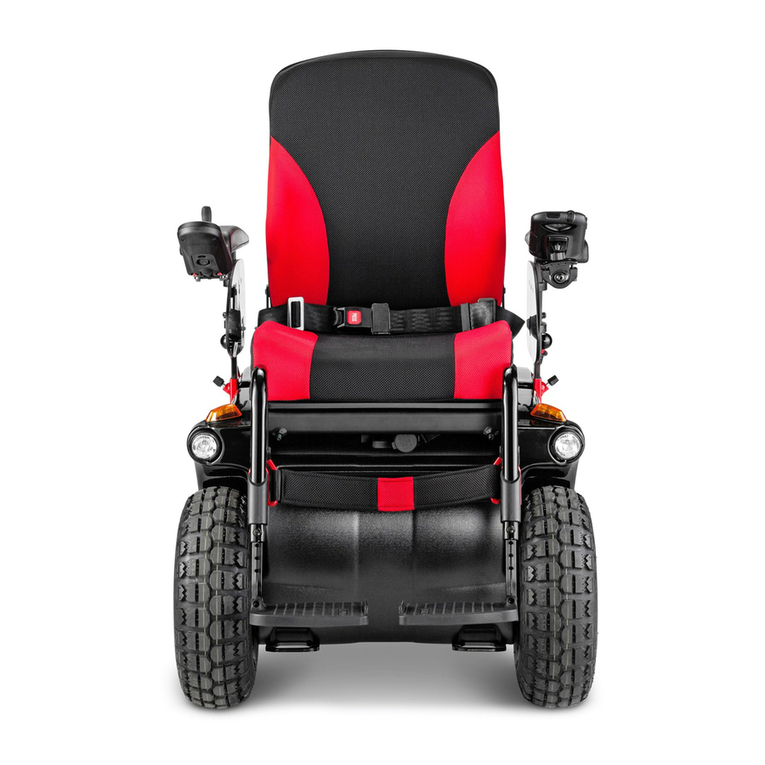
Meyra
Meyra 2.322 Manual
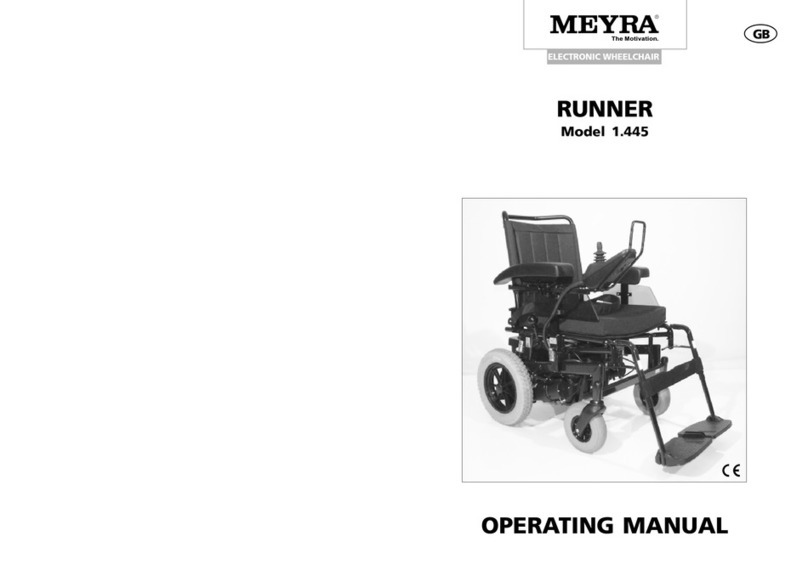
Meyra
Meyra RUNNER 1.445 User manual
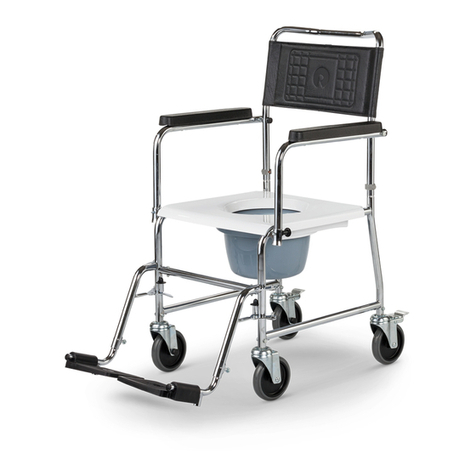
Meyra
Meyra 5HCDA User manual

Meyra
Meyra 9.050 User manual

Meyra
Meyra Ortopedia 1.054 User manual
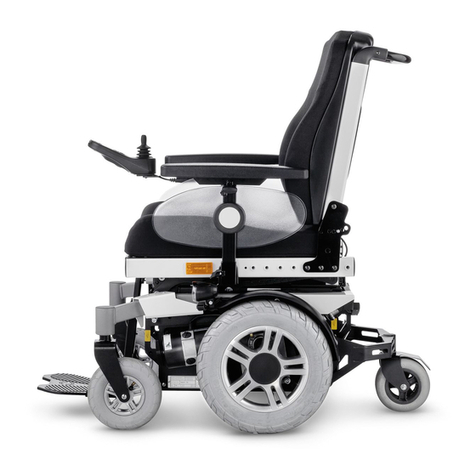
Meyra
Meyra 1.617 User manual
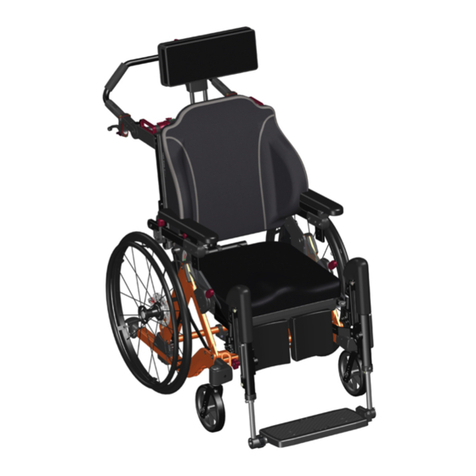
Meyra
Meyra Netti DYNAMIC AdaptPro User manual

Meyra
Meyra Polaro II 1.745 User manual
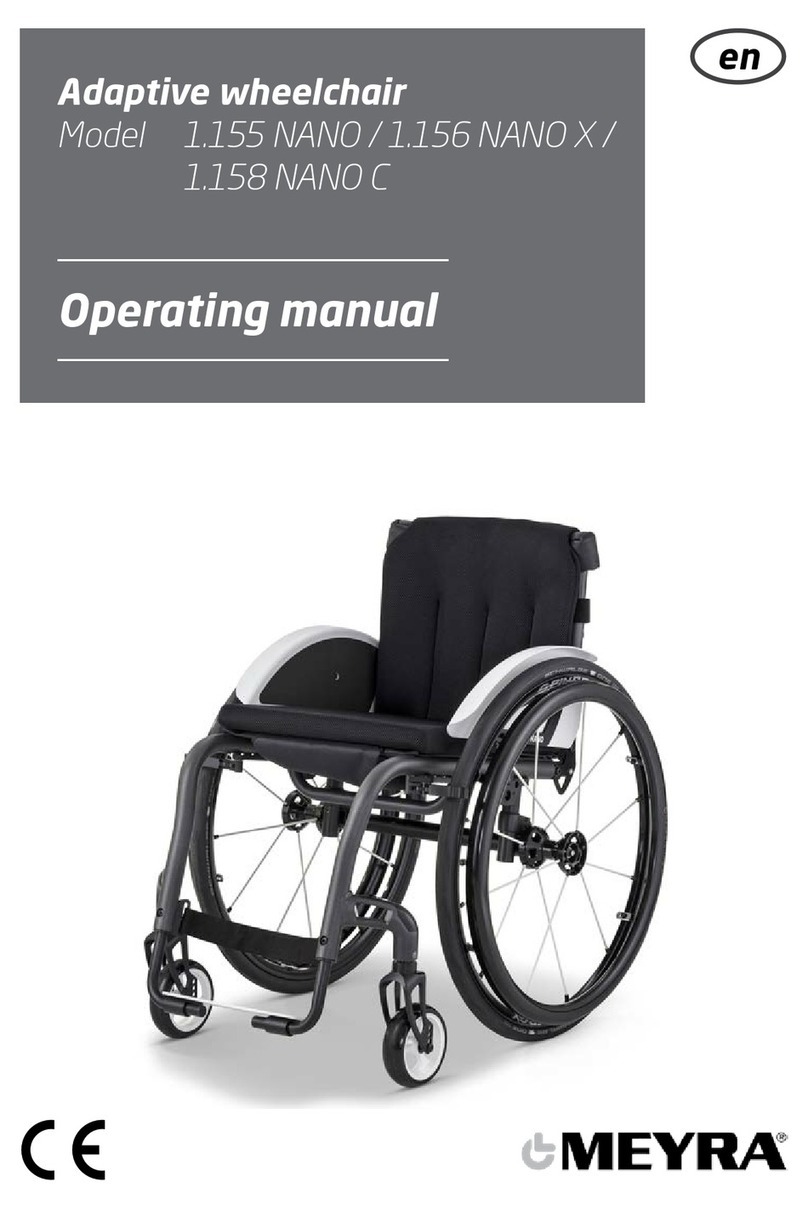
Meyra
Meyra 1.158 NANO C User manual
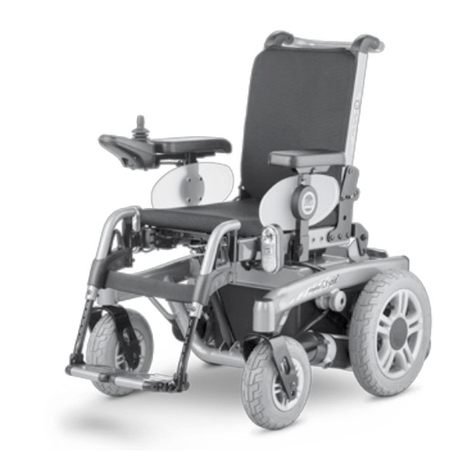
Meyra
Meyra 1.610 User manual
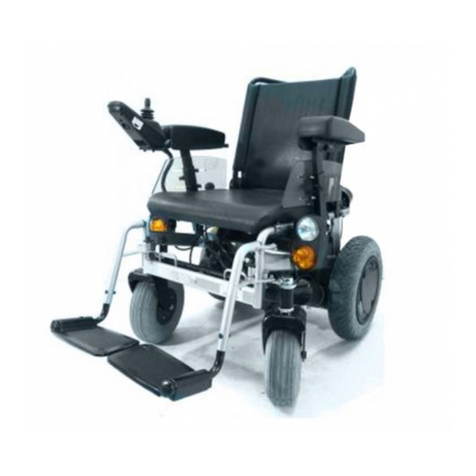
Meyra
Meyra Sprint Operating instructions

Meyra
Meyra 1.595-603 User manual

Meyra
Meyra 2.445 User manual

Meyra
Meyra X1 User manual
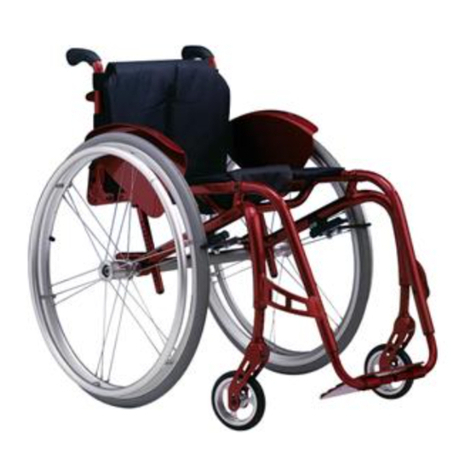
Meyra
Meyra FX One 1.150 User manual

Meyra
Meyra 9.050 User manual

Meyra
Meyra 9.500 User manual
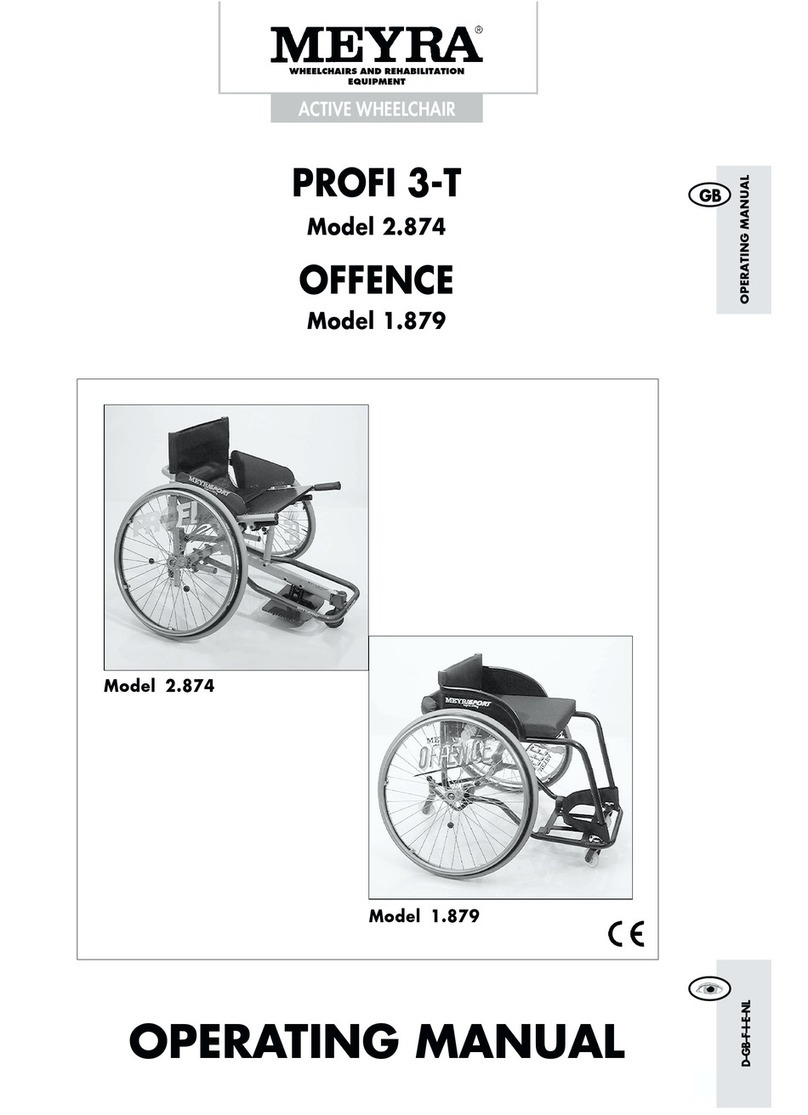
Meyra
Meyra PROFI 3-T 2.874 User manual
